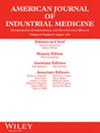Prevalence of COVID-19 and Long COVID by Industry and Occupation: Behavioral Risk Factor Surveillance System 2022
Abstract
Background
Workers in healthcare and other essential occupations had elevated risks for COVID-19 infection early in the pandemic. No survey of U.S. workers to date has comprehensively assessed the prevalence of both COVID-19 and Long COVID across industries and occupations (I&O) at a detailed level.
Methods
Behavioral Risk Factor Surveillance System data for 2022 from 39 states, Guam, and the U.S. Virgin Islands were used to estimate prevalence of self-reported history of COVID-19 and Long COVID, as well as the prevalence of Long COVID among those reporting prior COVID-19, by broad and detailed I&O. Adjusted prevalence ratios were used to compare outcome prevalence in each I&O to prevalence among all other workers combined.
Results
By broad I&O, workers in healthcare, protective services, and education had elevated prevalences of COVID-19. The prevalence of Long COVID was elevated in healthcare and protective service but not education workers. Detailed I&O with significantly elevated prevalences of COVID-19 but not Long COVID included Dairy Product Manufacturing industry workers and subsets of mining workers. Both COVID-19 and Long COVID were elevated among bartenders/drinking places and personal care and appearance workers. The prevalence of Long COVID was elevated among farmworkers who reported having had COVID-19.
Conclusions
Industries and occupations with elevated levels of COVID-19 or Long COVID in this study may warrant increased measures to prevent transmission of airborne respiratory viruses. Accommodations are a key component for supporting workers in all workplaces. This new information about the distribution of Long COVID by I&O suggests where employer understanding and implementation of tailored workplace supports and accommodations are most needed to support continued employment of affected workers.

 求助内容:
求助内容: 应助结果提醒方式:
应助结果提醒方式:


